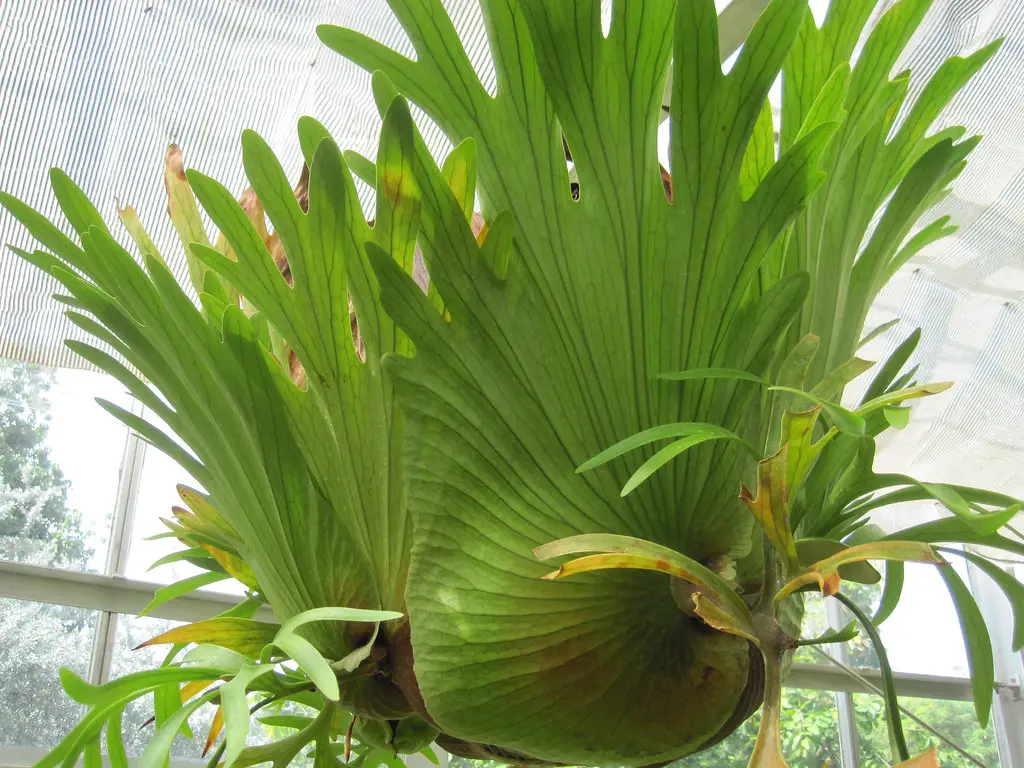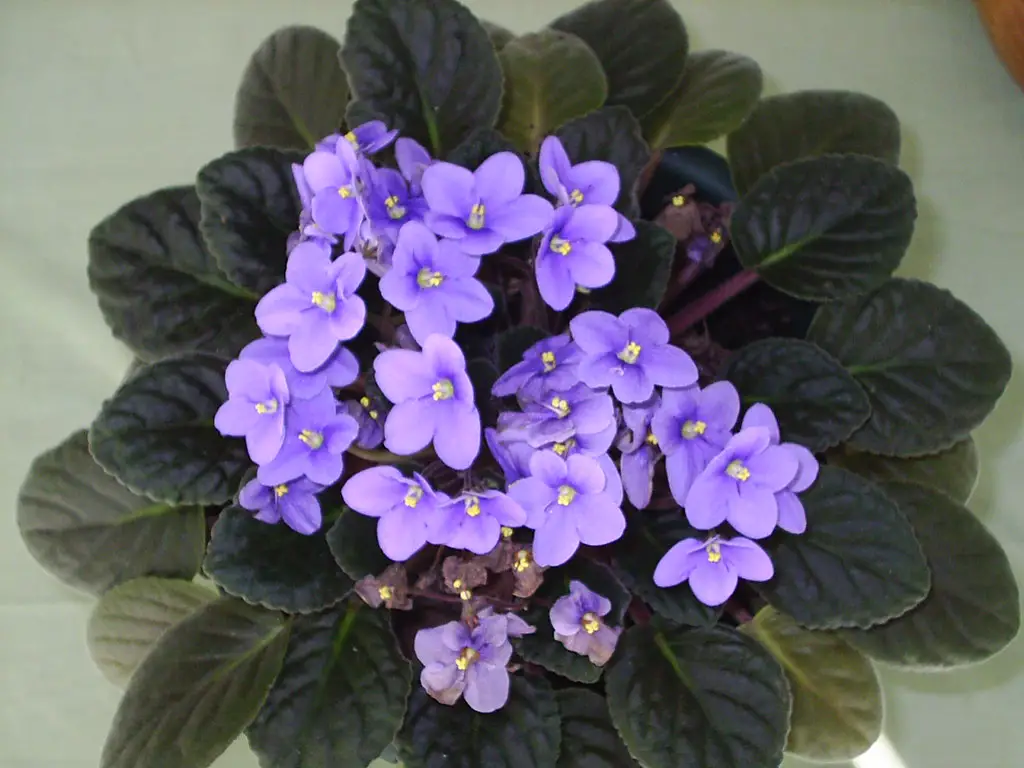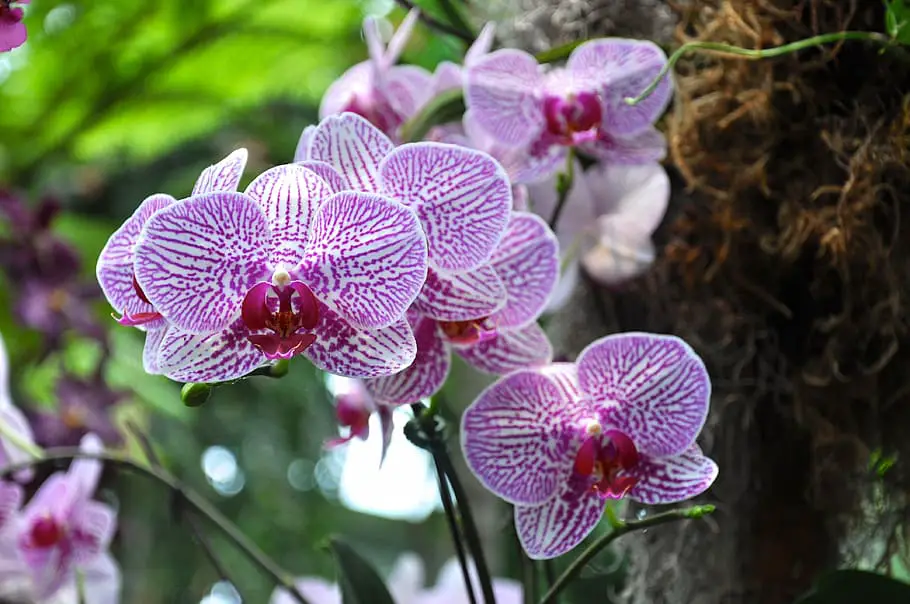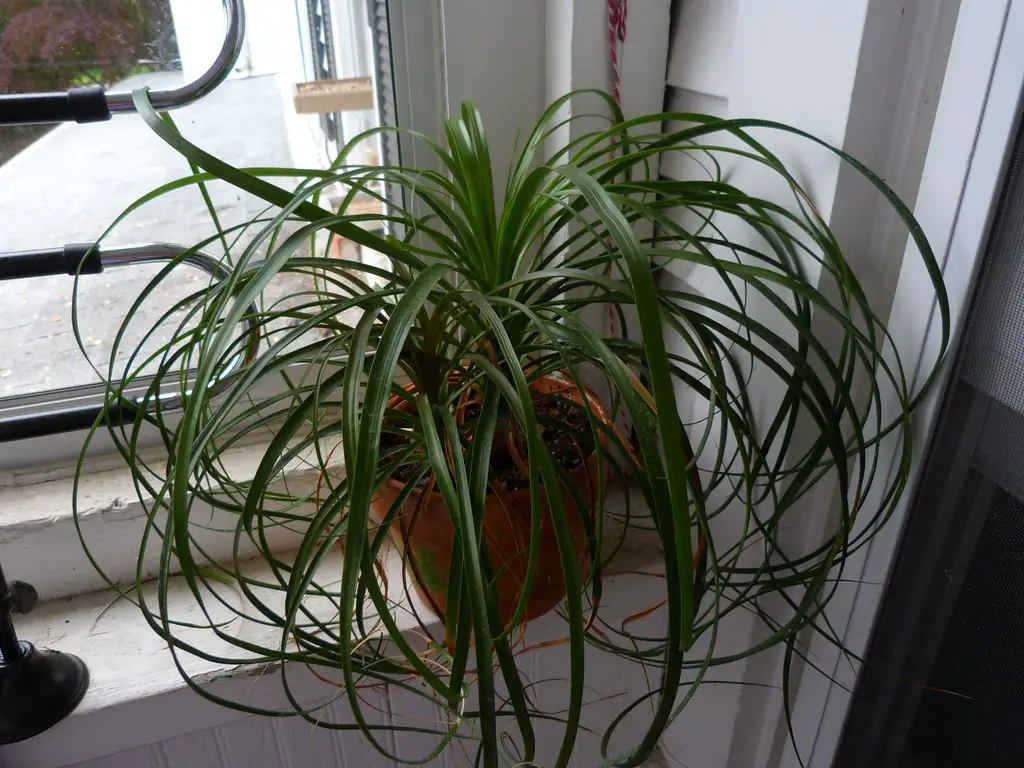Houseplants brighten up homes. A study conducted by researchers at Chungnam National University even found that interaction with houseplants may reduce psychological and physiological stress by suppressing autonomic nervous system activity in young adults (Lee et al., 2015). However, keeping a plant alive can be intimidating for some people.
The following article discusses ten houseplants that are suitable for beginners. According to the ASPCA, these plants are also non-toxic to dogs and cats.
1. Spider Plant

Chlorophytum comosum, which is often referred to Spider Plant, is a common type of hanging plant. Spider Plant is available in green and variegated varieties. Bonnie Spider Plant is a variety of Spider Plant with curled leaves and variegated coloring. “Baby” Spider Plants, which are little swirls of curly leaves, add an artistic flair to the plant. Interestingly, Bonnie Spider Plants tend to have more dramatic curls if you keep their soil on the drier side. In other words, they thrive on neglect!
Spider Plant exploded in popularity during the 1970s as the plant went well with the geometric shapes and wood paneling that are characteristic of 1970s interior design trends.
These plants do not require extensive care and can tolerate some abuse/neglect. Spider Plant prefers to be grown in bright light and do best when placed next to a west-facing or east-facing window. Like many other houseplants, Spider Plant prefers for the soil to remain moist at all times. Allow the top one inch of soil to dry out completely between watering sessions.
Spider Plant does not require a significant amount of fertilizer. Fertilize Spider Plant with an all-purpose fertilizer diluted to half strength once or twice per year. Over-fertilization can harm the plant and can cause the leaf tips to turn brown.
2. Zebra Haworthia

Zebra Haworthia is another great plant for beginners, especially for those who live in small spaces. Zebra Haworthia have dark green leaves with white stripes. These stripes make Zebra Hawthoria an ideal plant for fun, colorful containers. Zebra haworthia is often referred to as zebra cactus even though it is not actually a cactus as these plants do not have any spines.
Haworthias are commonly confused with aloes. They do share some similarities as Haworthias and Aloes both belong to the Asphodeloideae family. One of the most notable differences between Aloes and Haworthias is their size. Unlike Aloes, Haworthias are always small and grow very slowly.
Zebra Haworthia is a great plant for people who travel frequently because they can go several weeks (or months) without water. Like other succulents, these plants do best if they are watered thoroughly after the soil is allowed to dry out completely.
Like other succulents, Zebra Haworthia likes a lot of bright light. Ideally, your Zebra Haworthia should be in a location that receives at least 4-6 hours of sunlight in the morning.
These plants are not very tolerant of cold temperatures, so avoid placing them next to a drafty window. If you live in a home that gets cold during the winter, consider putting your Zebra Haworthia on a heating pad to keep the soil warm.
3. Staghorn Fern

Staghorn Fern is a term that refers to several species of fern belonging to the Platycerium genus. Staghorn Ferns are probably my favorite type of houseplant at the moment. They have a modern, funky look and are fairly low-maintenance.
Unlike many other types of houseplants, Staghorn Ferns should NOT be grown in potting soil. Because Staghorn Ferns grow epiphytically in nature, they should be grown in a medium comprised of sphagnum moss and orchid bark.
epiphyte – a plant that grows on another plant but is not parasitic.
Staghorn Ferns should be placed in a location that is exposed to medium to bright light. If these plants are not exposed to enough sunlight, they will begin to slowly decline.
A general rule of thumb is to water your Staghorn Fern once per week during the warmer months and once every other week during the colder months. You should allow the growing medium to dry completely between watering sessions. I have found that my Staghorn Fern starts to get a little droopy when it needs water.
To learn more about Staghorn Ferns, check out this article I wrote about Staghorn Ferns.
4. Boston Fern

Ferns are great plants for low-light conditions and thrive in humid environments like bathrooms. Interestingly, ferns are among the oldest plants on Earth. Scientists have found fossils that indicate ferns have inhabited Earth for at least 380 million years (Taylor, Taylor, and Krings, 2009). This means that ferns inhabited Earth before the dinosaurs. Today, they are among the most diverse types of plants in the world.
Like most other types of ferns, Boston Ferns do best when their soil is kept evenly moist (not soggy or saturated) at all times. Allowing a fern’s soil to dry out completely between watering sessions will cause the plant to become stressed. To ensure that the soil does not dry out too much, add moss around the base of the fern. The moss will help the plant retain moisture.
Although Boston Ferns grow best in soil moisture, they are still prone to root rot caused by overwatering. To prevent root rot, it is important to grow your Boston Fern in well-draining soil. A good soil mix for Boston Ferns is comprised of 2 parts peat moss, 1 part perlite, and 1 part sand.
5. Peperomia caperata

Peperomia caperata, which is commonly known as Emerald Ripple Peperomia, is a semi-succulent species of Peperomia and is a common type of houseplant. There are many cultivars or variations of Peperomia caperata, but they all have ripply leaves that have a leathery texture. These plants are fairly compact and grow to be about 8 inches tall and 8 inches wide. In addition to being small, this plant is tolerant of low light conditions and is fairly low maintenance making it a perfect plant for offices or dark corners.
Peperomia caperata grows best when kept in a location that is exposed to medium light that is typical of north-facing or east-facing windows. However, it can tolerate low-light conditions for several months. Although Pepeormia caperata do best when they receive natural sunlight, these plants will also do well under fluorescent lighting.
Although Peperomia caperta is a low-maintenance plant, it does require consistent watering during its growing season which extends from spring through fall. To avoid overwatering your Peperomia caperata, it is important to allow the top 4-5 inches of soil to dry out completely between watering sessions. Peperomia caperta grows more slowly during the winter months, so water more sparingly during that time.
To learn more about Peperomia caperata, check out this article that I wrote about Peperomia caperata.
6. Christmas Cactus

The Christmas Cactus belongs to the Schlumbergera genus, which is a small genus comprised of plants that are native to southeastern Brazil. These species have flattened stems and elongated flowers. Unlike many other cacti, the Christmas cactus (and other plants belonging to the Schlumbergera genus) is not from a hot, dry climate. They are actually native to the coastal mountains of southeastern Brazil which is a tropical area.
Although you will find many “Christmas Cacti” for sale at big box stores an nurseries, the vast majority of these plants are actually Thanksgiving Cacti. If you want a true Christmas Cactus, you will need to purchase some cuttings from an online marketplace such as Etsy or eBay.
So what are the differences between a Christmas Cactus and a Thanksgiving Cactus? They actually look very similar. However, Christmas Cacti (Schlumbergera x buckleyi) have leaves with rounded edges. In contrast, Thanksgiving Cacti have pointy, jagged leaves. Thanksgiving Cacti also bloom one month sooner than Christmas Cacti.
Christmas Cacti and Thanksgiving Cacti have care requirements that are typical of succulents. However, blooming is especially exciting with these plants. To force your holiday cactus to bloom, place your plant in a dark, cool area for at least 12 hours a day for 6 to 8 weeks prior to blooming.
To learn more about caring for a Christmas Cactus or Thanksgiving Cactus, check out this article I wrote about the Christmas Cactus.
7. African Violet

Saintpaulia wendl, which is commonly known as the African Violet, is native to eastern tropical Africa. This plant has a rich horticultural history. The African Violet was first discovered in Tanzania in 1892 by by Baron Adalbert Emil Walter Redcliffe Le Tanneaux von Saint Paul-Illaire, a German colonial official. His father, who was a hobby horticulturalist, planted the seeds of this plant and grew the first African Violet sample in Germany.
In 1894, the first African Violet samples arrived in the United States. They were first presented to the public by a florist in New York. However, people found African Violets difficult to grow due to the climate. When the fluorescent light bulb was introduced, the African Violet became popular again. The light bulb allowed people to keep their African Violets alive.
African Violets became so popular because they bloom year round. They are also fairly low maintenance. Simply keep the soil moist with room-temperature water and keep the plant away from drafty doors and windows.
African Violets prefer to need plenty of bright light. An ideal location of an African Violet is near a north-facing or east-facing window. Dark green leaves and leggy stems are signs that your African Violet needs more light. Light green or pale leaves are an indication that your plant is being exposed to too much light.
8. Orchids

The orchid family (Orchidaceae) is comprised of over 25,000 species of flowering plants which make it one of the most diverse families of plants on Earth. The most common orchids found sold in stores are Phalaenopsis, Dendrobium, and Oncidium. The easiest type of orchid to grow is the Phalaenopsis. It is also the easiest orchid to get to rebloom.
According to the American Orchid Society, the best way to see if your orchid needs more water is to use the pencil trick. The pencil trick involves pushing the pointy end of a pencil into the growing medium. If the end of the pencil is dark due to the moisture in the growing medium, hold off on watering. If you aren’t sure whether you should water, wait one more day.
Although orchids are widely available today, this was not always the case. During the Victorian era, orchids became very popular among the wealthy. Orchid hunters traveled to the jungles of South American and the South Pacific to find orchid plants for the wealthy patrons. Orchid hunting was extremely dangerous, and hunters even killed each other in pursuit of the perfect orchid specimen. Today, anyone can enjoy growing an orchid in their home regardless of their socioeconomic class.
In the wild, orhids grow as epiphytes. This means they grow on trees rather than soil. For this reason, you should not repot your orchid into potting soil. It needs a growing medium that consists of bark. If you repot your orchid, always use an orchid mix.
Ideally, you should place your orchid near but not directly next to a south-facing or east-facing window. If you place your orchid in a low-light bathroom, it will probably do okay (as long as it gets some light). However, it will probably never bloom again. The most common reason that orchids do not bloom is insufficient light.
9. Money Tree

Money Tree are beautiful, hardy plant that can be found at supermarkets, nurseries, and Asian Markets. They are typically sold in fun containers and have a modern aesthetic. These plants thrive in humid environments which makes them a great plant for bathrooms.
Money Trees are actually multiple Pachira aquatica plants braided together. These braided trees typically come in sizes ranging from 1 to 6 feet. In the wild, Pachira aquatica can grow to a height of almost 60 feet!
Over time, some of the leaves on your Money Tree will fall off. When this happens, there is no reason to be concerned. It is completely normal for Money Trees to lose some leaves. In fact, pruning the dead leaves will encourage your Money Tree to continue growing even more leaves.
Money Trees do not require a lot of fertilizer, but they do look best when fertilized 1-2 times each year during the growing season (late spring through summer). I have found that Money Tree has started growing larger leaves since I started fertilizing it.
Overwatering is the most common killer of these plants. Excessive watering can cause root rot. Signs of root rot include drooping or yellowing leaves and a generally unhealthy appearance. Eventually, the trunk will become mushy, and the plant will die. If you do find that one of the Pachira aquatica plants is rotting, carefully unbraid your Money Tree and remove the rotting plant. This will prevent any diseases from spreading.
10. Ponytail Palm

Beaucarnea recurvata, which is commonly known as Ponytail Palm, is a slow-growing plant that requires very little care. These plants are native to eastern Mexico. the Ponytail Palm is drought tolerant and can survive extended periods of time without water which makes them a good houseplant for people who travel frequently.
Ponytail Palms grow best when exposed to bright, indirect light. An ideal spot for a Ponytail Palm would be a windowsill or a sunny room next to a south-facing window.
Although Beaucarnea recurvata has earned the common name “Ponytail Palm,” it is not a palm tree at all! It is actually a succulent that belongs to the Asparagaceae family. Like other succulents, this plant should be watered thoroughly after allowing the soil to dry out completely. This is commonly referred to as the soak and dry method.
To help your Ponytail Palm maintain a healthy appearance, fertilize once per year with an all-purpose houseplant fertilizer diluted to half strength.

